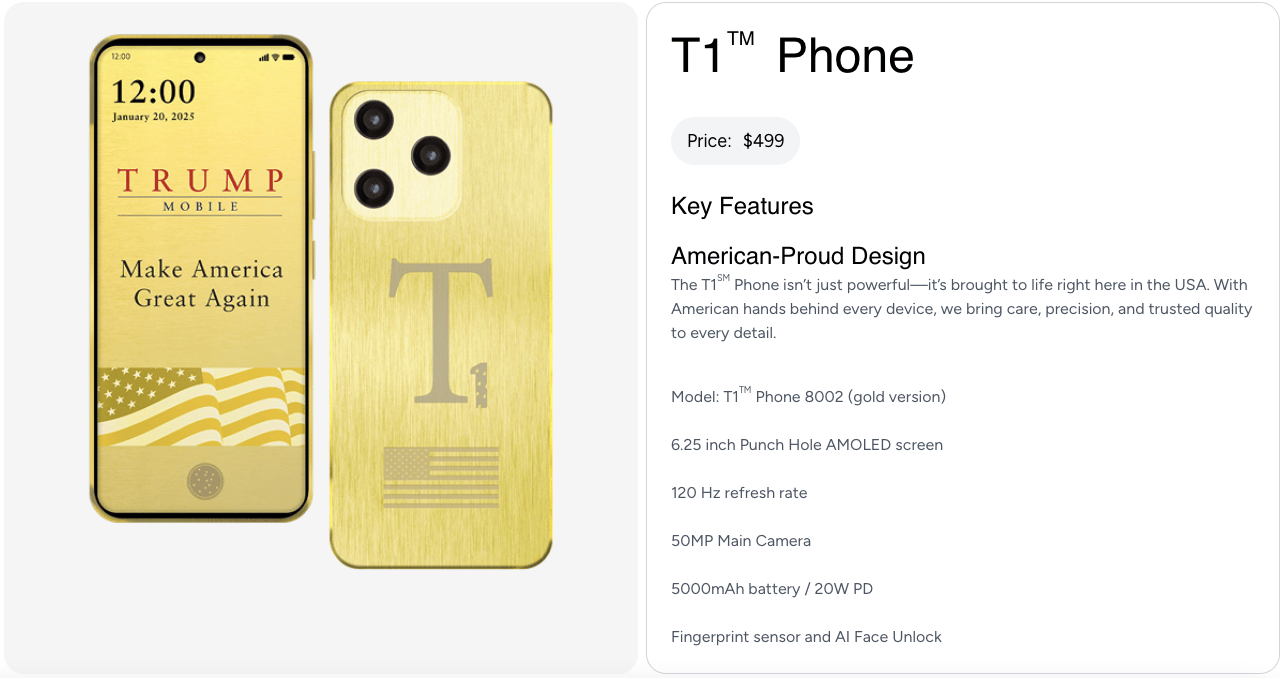Trump smartphone drops 'Made in the USA' language
The Trump-branded T1 phone dropped promises of American manufacturing amid growing skepticism over its origin, technical specs, and FCC approval status

Trump Mobile
When the gold-colored Trump Mobile T1 smartphone was announced earlier this month, the pitch was red, white, and blue: a MAGA-friendly iPhone alternative designed and assembled in the U.S. Now, that claim is quietly missing in action.
Suggested Reading
Trump Mobile has scrubbed “Made in the USA” language from its site, messaging that had fueled a key marketing pillar: an American‑built phone for “real Americans.” Instead, the language has been replaced with looser phrases such as “Proudly American” and “American-proud design.” The website says the devices are “designed with American values in mind” and that there are “American hands behind every device.”
Related Content
Gone are the specifics about assembly in Alabama, California, and Florida. What remains is a $499 phone with shifting specs, a vague launch timeline, and mounting questions about where — and how — this phone is actually being made.
The repositioning comes just weeks after tech observers began digging into the phone’s origins and specs, which haven’t aged gracefully, either.
Early marketing materials listed high-end features: a 6.78-inch AMOLED display, 12 GB of RAM, and a 5,000 mAh battery. Now, the site lists a smaller 6.25-inch screen and omits key technical details entirely. The language is fuzzier — and the details are thinner. Meanwhile, press images still show a phone that looks strikingly similar to low-cost Android devices sold under generic or white-label brands — which has led to some speculation that the T1 is simply a rebranded model from an overseas manufacturer.
That might make sense, logistically. Building a smartphone in the U.S. from scratch is all but impossible without a massive stateside supply chain — and virtually no consumer electronics companies, including Apple (despite President Donald Trump’s best attempts to get them to do so), have pulled it off at scale.
Experts point to signs that the TI might be the T-Mobile Revvl 7 5G (available on Amazon for $169) in disguise, or that the phone could be a variant of devices manufactured by Chinese original device managers (ODMs) such as Wingtech or Doogee, then shipped stateside for rebranding. If so, the original “Made in the USA” marketing wasn’t just aspirational — it was misleading.
Preorders for the Trump T1 are currently open, with a $100 deposit securing a spot in line for a product that still lacks a confirmed ship date. While the original marketing promised a September launch, that timeline has quietly slipped to a vague “later this year.” Customers haven’t been shown a working device, nor have they been offered detailed specs or third-party reviews — just a few product renders, a spec sheet in flux, and the promise of “premium performance.”
The phone’s network offering, branded as the “47 Plan” and offered for $47.45 a month (a nod to Trump being both the 45th and 47th president), adds another layer to the whole thing.
Promoted as a patriotic alternative to mainstream carriers, the plan touts “nationwide coverage” but provides no transparency about its infrastructure. The plan relies on an MVNO arrangement — essentially piggybacking off an established U.S. telecom network. That setup isn’t unusual in the industry, but the marketing language used by Trump Mobile could invite regulatory scrutiny if it’s found to mislead consumers about the nature of the service or its ownership.
More broadly, the Federal Communications Commission (FCC) has authority over both wireless carriers and the certification of mobile devices sold in the U.S. So far, there’s no public evidence that the Trump T1 has passed through FCC approval. Without that, it cannot legally be sold or activated. And if the phone is, in fact, a white-labeled foreign model rebranded for political appeal, that could raise red flags around both compliance and consumer protection.
Right now, the T1 exists in a kind of limbo: a symbolic object rather than a ready-to-ship device, wrapped in gold and draped in ambiguity. Whether it ever makes it into customers’ hands — or if it survives scrutiny when it does — remains very much in question.
